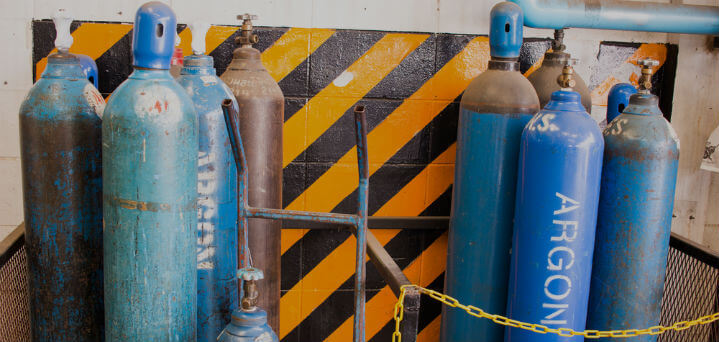Fires, toxic gas exposure, explosion, and oxygen displacement – these compressed gas hazards pose threats to you and your employees. It’s important to abide by special handling, use, and storage guidelines so that these hazards might be avoided altogether.
Compressed Gas Cylinder Hazards
Is compressed gas in a cylinder a physical hazard? It most certainly is. In a matter of seconds, the 1963 Indiana State Fair turned dark. Within the Coliseum, spectators gathered for an ice-skating performance.
A leaky valve on a rather small propane tank was the cause of the disaster. All along, it was assumed that the tank was running a heater, but with the leak, much of the gas escaped. When it ignited, 74 people were killed, and another 400 were injured.
Explosions like this are rare, and remind us of why it’s so important to heed these potential hazards. Compressed gas cylinder safety is important on the work-site. We must be extra careful that we don’t become so accustomed to seeing these tanks and moving them that we let our guards down and forget the dangers that they pose.
Here’s a quick list of hazards associated with gas cylinders:
- Weight alone: If these cylinders fall or roll, their weight alone can trigger a disaster, do damage, and injure or even kill workers.
- Threatening contents: Within these gas cylinders may be threatening contents that are flammable, explosive, or corrosive.
- Projectile potential: Because these gas cylinders are pressurized, projectile potential is a concern. If a valve breaks off or a regulator becomes detached, they can be projected across work environments, flying at dangerous speeds and harming those in their path.
Consider using safety consulting companies like Safety by Design to evaluate your company’s daily routines. We provide the expertise required for recognizing hazards and keeping you OSHA compliant on all levels. We can even train your workers in high pressure cylinder safety and so much more.
Compressed Gas Cylinder Safety

Wondering how to store compressed gas cylinders? Curious about how to move them properly? In this section, we’ll look at OSHA gas cylinder storage and handling guidelines. We’ll discuss the basic gas cylinder safety tips and practices below because momentary lapses in the correct storage and handling of these high-pressure tanks can result in disaster for all in any given area.
OSHA Compressed Gas Cylinder Storage
OSHA compressed gas cylinder storage requirements should be followed on your site. A tank’s exposure to heat can render cracks and other weaknesses in the gas cylinders’ shells. This could obviously lead to a deadly explosion.
Here are the compressed gas cylinder storage tips:
- Keep the tanks away from the sun, flames, sparks, and areas that reach and exceed 125 degrees Fahrenheit.
- Include firewalls for cylinders with contents that pose different types of hazards. (Oxidizers should not rest within twenty feet of gases which are flammable.) Separate the cylinders or opt for the wall.
- Store acetylene cylinders upright always. The contents are unstable. If left on its side, the liquid acetone might leak out through the tank’s valve. This is a fire hazard.
- Never use copper tubing or fittings with acetylene cylinders.
- Cylinders should be secured so that they can’t cause injury or damage surrounding machinery. Use guards, chains, straps, or “dog bones” to avoid rolling or tipping cylinders. The weight of the cylinders should not exceed the max limit of any of these securing devices.
- Do not remove the cylinder’s cap without the tank being secure.
Want to ensure proper storage and give yourself and your employees peace of mind today? Contact Safety by Design today. We understand these compressed gas cylinder regulations, and we design safety solutions that your workplace can quickly put into practice.
Safe Handling of Compressed Gas Cylinders

Safe handling of gas cylinders is of the utmost importance on a job site. Tipping a cylinder or dropping it can pose fatal problems. In fact, most incidents each year occur as workers handle gas cylinders or as these tanks are being transported.
Here’s a list of tips for safe moving:
- You should avoid dropping the cylinders and bumping/hitting them against fixtures, walls, etc.
- Workers should follow their training and the procedures they learned.
- Proper footwear, protective eye wear, and gloves should always be worn when handling.
- Caps and guards should be installed correctly and securely.
- Hand trucks and carts are ideal for moving cylinders. Avoid rolling and dragging these tanks in the work environment.
- When using a crane, be sure nets, cradles, and/or platforms are in place.
- To avoid damaging the valves, do not move gas cylinders with slings or magnets, and do not lift them by their guards or by their caps.
Don’t Delay – Contact Safety by Design
Compressed air cylinder safety isn’t something you can overlook. When worker safety is at stake, you can’t get started soon enough. Contact us online today to use Safety by Design’s OSHA safety compliance training services.



